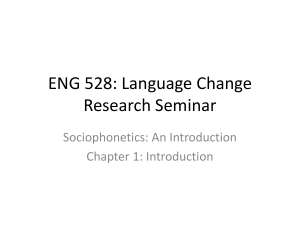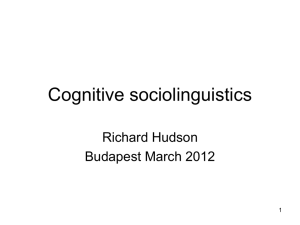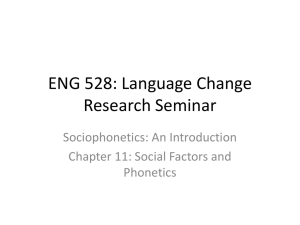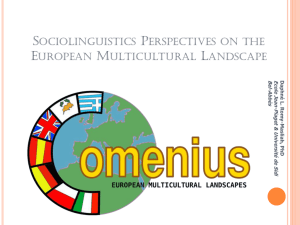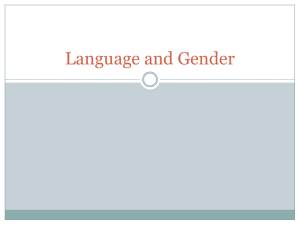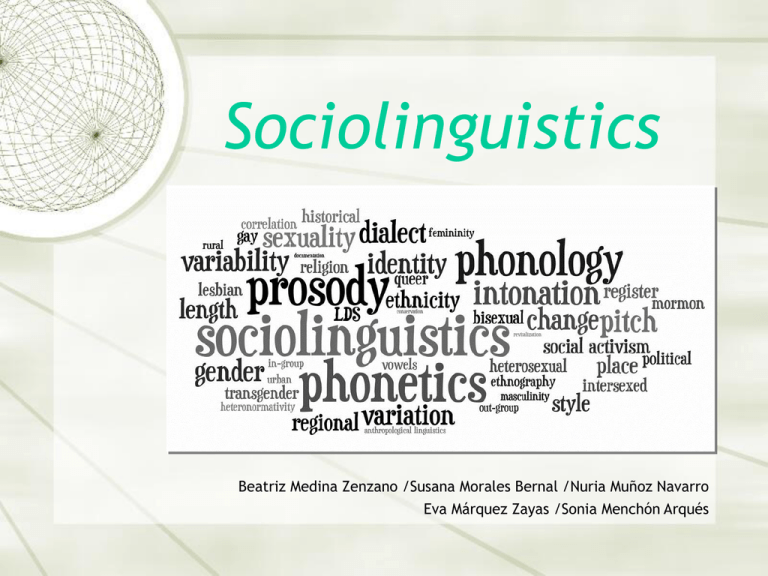
Sociolinguistics
Beatriz Medina Zenzano /Susana Morales Bernal /Nuria Muñoz Navarro
Eva Márquez Zayas /Sonia Menchón Arqués
Contents
1. Definition of Sociolinguistics
2. Origins and main figures
3. Areas of Sociolinguistics
4. Language and gender
5. An instance of empirical studies
6. Conclusion
1.DEFINITION OF SOCIOLINGUISTICS
Descriptive study – how society influences language
“Sociolinguistics is the descriptive study of the effect of
any and all aspects of, including cultural, expectations,
and context, on the way is used, and the effects of
language use on society”.
“…The focus of sociolinguistics is the effect of the society
on the language, (…)”
“It also studies how language varieties differ between
groups separated by certain social variables, e.g.,
ethnicity, religion, status, gender, level of education,
age, etc (...)”.
(http://en.wikipedia.org/wiki/Sociolinguistics).
Sociolinguistic investigation – language study within social context
(Trudgill)
“The aim of sociolinguistic investigation is to achieve a
further progress in the knowledge of nature and the
operation of human language by the study of language in
its social context. Besides, all Sociolinguistics is language
and society but, however, not all language and society
are Sociolinguistics” (Trudgill, 2000).
Interdisciplinary science (Campoy & Almeida)
“Sociolinguistics is an interdisciplinary science which is
concerned with relationships between language and
society”, (Campoy & Almeida, 2005).
Characteristics of sociolinguistics (Campoy, 1993)
A science, which is concerned with the relationship between
language and society.
A branch of Linguistics.
It considers that language is a social and a cultural
phenomenon.
It studies language in its social context, in real life situations by
empirical investigation.
It is related to methodology and contents of social sciences.
2. ORIGINS AND MAIN FIGURES
ORIGINS:
Saussure & Chomsky concepts
PROMINENT FIGURES:
William Labov & Peter Trudgill
“Sociolinguistics has its roots in
dialectology, historical linguistics, and
language contact with considerable
influence from sociology and psychology
(Koerner 1991: 65). This is why it has
evolved into an exceptionally broad
field.” (Sali A. Tagliamonte, 2012).
New discipline of Linguistics:
Developed from the last 30 years.
Origins focused on:
1. The structure of langue/parole & the
diachronic/synchronic suggested by Ferdinand de
Saussure:
-
Langue/Parole – Internal Linguistics / Microlinguistics
(phonology, morphology, syntax)
-
Diachronic/Synchronic – External Linguistics/
Macrolinguistics (acquisition-use of language and
culture-society-language connection)
2. The competence/actions notions by Noam
Chomsky.
According to Trudgill
Macrolinguistics focused on the study of the language
(large-scale - group behaviour).
Microlinguistics focused on the description-analysis of
languages (small groups).
SAUSSUREAN CONCEPT OF LANGUAGE
Related with Chomsky’s competence:
• Focused on the ideal speaker/listener (control of
language - a homogeneous community).
• Languages - autonomous and coherent systems
IN THE PAST: linguistics focused on microlinguistics,
ignoring macrolinguistics.
Prominent Figures
United States & United Kindgom
WILLIAM LABOV: regarded as the one who started it with
his theories in his empirical works:
The social stratification of English in New York City (1966)
Sociolinguistics Patterns (1972)
• Sociological methodology – with theoretical
implications for Linguistics
• His study – based on empirical work in social context
• Objective – mechanism of linguistic changes &
structure of linguistic systems
William Labov
The first one to put into practice the area of
sociolinguistics in the United States.
Peter John Trudgill
Later in the United Kingdom
• The British complement for the secular linguistics
of Labov.
The Social Differentiation of English in Norwich (1971)
Sociolinguistic Patterns in British English (1972)
3. TYPES AND AREAS OF
SOCIOLINGUISTICS
Sociology of language: Aspects related with
sociolinguistics and language.
Social psychology of language: Linguistic attitudes and
several aspects of linguistic usage in a face-to-face
conversation.
Anthropological linguistics: Its
objective is to study in depth
the knowledge of the social
structure of communities.
Ethnography of ommunication:
It focuses on the role that
language plays in the
‘communicative conduct of
communities’ from the different
cultures in their different ways
of manifestation (styles, dialects
and languages).
Discourse analysis: The study
of texts and conversational
interaction
-textual linguistic
-conversational analysis
Geolinguistics: Mixture among secular linguistics,
dialectology and human geography. Focuses on the
geographical distribution of linguistics.
Dialectology:
The academic
study of dialects and the
geographical distribution
of these dialects.
Secular linguistics:
Carried out by empirical
works. The objectives of
this discipline are similar
to the ones of linguistics
4. LANGUAGE AND GENDER
Context of study
Variation Approach within Sociolinguistics
“Variationist Sociolinguistics” or “Language Variation and
Change (LVC)”.
Origins: “Labovian Sociolinguistics”, “Quantitative
Sociolinguistics” or “Secular Linguistics”, according to Trudgill
(1978b:11).
Aim: To link “social variation” and “linguistic variation”
resulting on “sociolinguistic variation”.
Empirical research: to formulate a “sociolinguistic theory”.
Studied BY and HOW
Gender and Language relationships – studied by:
Sociolinguistics, Pragmatics, and Discourse Analysis among others.
Division of research started at the 1960s:
- Investigation on sexism in language.
- Influence of gender “as a social variable” in language.
‘SEX’ vs. ‘GENDER’
‘Sex’ and ‘Gender’ together with “social context” -
“social class” - “ethnicity”.
The 4 biggest “forms of social differentiation”
(Trudgill, 2002).
Different perspective
Influenced by Feminism
‘Sex’ – Biological, physiological differences between women and men.
‘Gender’ – Used to establish that distinction BUT in terms of social
and cultural aspects.
Sociolinguistics – more concerned with the concept of ‘gender’.
ANALYSING differences between women and men in relation to
language in social context.
Mainly Quantitative research (variation theory) and also qualitative
study –in terms of several features of language- TO ANALYSE
differences.
Language aspects under study, little example
Gender and language - focusing on aspects of language,
such as:
•
vocabulary and phonology, among others.
Regarding vocabulary
•
SEXIST LANGUAGE, NOT NEUTRAL-GENDER – Denoting inequality
through language : influenced by sexist society.
EXAMPLES:
In Spanish – use of adjectives ‘cojonudo’ (good) –
‘coñazo’ (boring).
In English – Title names:
Male – ‘Mr’ / Female – ‘Mrs’, ‘Miss’, ‘Ms’.
Regarding phonology – Important
research through Lavobian approach.
Concluded:
• Women tend to use phonological variants
usually related to a HIGHER SOCIAL STATUS.
• MUCH DISCUSSION about this conclusion – often
challenged.
5. EMPIRACAL STUDY ABOUT
GENRE AND SOCIOLIGUISTICS
Gender and Genre Variation in weblogs
Susan C. Herring and John C. Paolillo (Indiana University, Bloomington)
“A relationship among language, gender, and discourse genre has
previously been observed in informal, spoken interaction and
formal, written texts. This study investigates the
language/gender/genre relationship in weblogs, a popular new
mode of computer-mediated communication (CMC)”.
Conclusion:
• Language in men's and women's blogs will often differ:
“Men's blogs are more likely to appear on 'A-lists' of most popular
weblogs (Kennedy, Robinson and Trammell, 2005) - this recalls the
traditional stigma associated with 'gossip' and women's writing
(Spender, 1989), and reminds us that genres are socially constructed”.
Hence: the final result of weblogs is directly related with
the producer’s genre but the study also suggests it is
necessary a deeper survey in CMC research .
Conclusion
Basically Sociolinguistics deals with language-society relationships and its
study is based on empirical analysis from real life social context.
Saussure and Chomsky concepts put somehow the origins of Sociolinguistics,
although the development would come later , first with Labov and later with
Trudgill.
We have found different directions of Sociolinguistics such as Dialectology
or Social psychology of language (in the direction of Labov and Trudgill surveys).
It was interesting to have a brief idea of how the relationship between
language and gender is studied within the field of Sociolinguistics, and how it is
powerfully connected with Feminism. To end up with this overview on
Sociolinguistics it was necessary to offer a small inside into recent empirical work
on the subject.
References
Chambers, J.K., Trudgill, P. & Schilling-Estes, N. (eds.) (2002) The Handbook of Language
Variation and Change. Oxford: Blackwell.
Hernández Campoy, J.M (1993) Sociolingüística Británica. Barcelona: Octaedro.
Hernández Campoy, J.M & Almeida M. (2005) Metodología de la investigación sociolingüística.
Granada: Comares.
Herring, Susan C. & Paolillo, John C. (2006). “Gender and genre variation in weblogs” in
Journal of Sociolinguistics, 10(4), 439-459. Bloomington: Indiana University.
Sali A.l Tagliamonte (2012). Variationist Sociolinguistics, Observation, Interpretation. Blackwell
Publishing Ltd.
Trudgill, P. (2000) Sociolinguistics: An Introduction to Language and Society. London: Penguin.
Hernández Campoy, J.M. (1993) Sociolingüística Británica. Barcelona: Octaedro.
Web references
http://en.wikipedia.org/wiki/Sociolinguistics
http://www.uni-giessen.de/genderproject/?p=205 (Language and Gender: Sociolinguistic and
Quantitative Perspectives - Svetla Rogatcheva)
http://alvarogomezcastro.overblog.es/pages/ESTUDIOS_SOBRE_LENGUAJE_Y_GENERO1786685.html
This work has been realized by:
Nuria Muñoz Navarro, Beatriz Medina Zenzano, Eva
Márquez Zayas, Susana Morales Berna and Sonia Menchón
Arqués for Applied Linguistics Subject (3º GEI)



